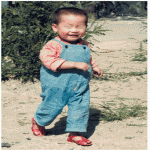Presentation | White host complexion with slight concealed redness Complexion is bright and lustrous, not lifeless |
 |
Several blue moles around the orbits Scars along the left cheek | Presentation | |
Primary disease diagnosis | Blood stasis due to liver constraint | |
Case example | Dizziness and vertigo Qi stagnation due to liver constraint causing blood stagnation in the collaterals Post hemangioma resection procedure | Primary disease diagnosis |
Inspection of form refers to examination of the body form and constitution, while bearing refers to the body posture, including body position and movements. Form and bearing can serve as outward clues helpful in diagnosing a patient’s internal condition. For instance, a strong and robust body is more susceptible to excess syndromes, while a weak body is more susceptible to def iciency syndromes. Furthermore, obese persons often have qi def iciency and are more likely to suffer from phlegm and dampness, and thus wind stroke. Thin persons, on the other hand, are more likely to have yin def iciency, making them susceptible to diseases such as tuberculosis (cough due to consumption), and def iciency f ire conditions. Observation of bearing can similarly produce clues to one’s internal condition. For instance, a person who likes to be active and tends to lay in a supine position is more susceptible to yang heat excess syndromes. Whereas, a person who tends to lay in a prone position and prefers to be quiet and still is more susceptible to yin-cold def iciency syndromes. | Case example | |
Stay updated, free articles. Join our Telegram channel

Full access? Get Clinical Tree








